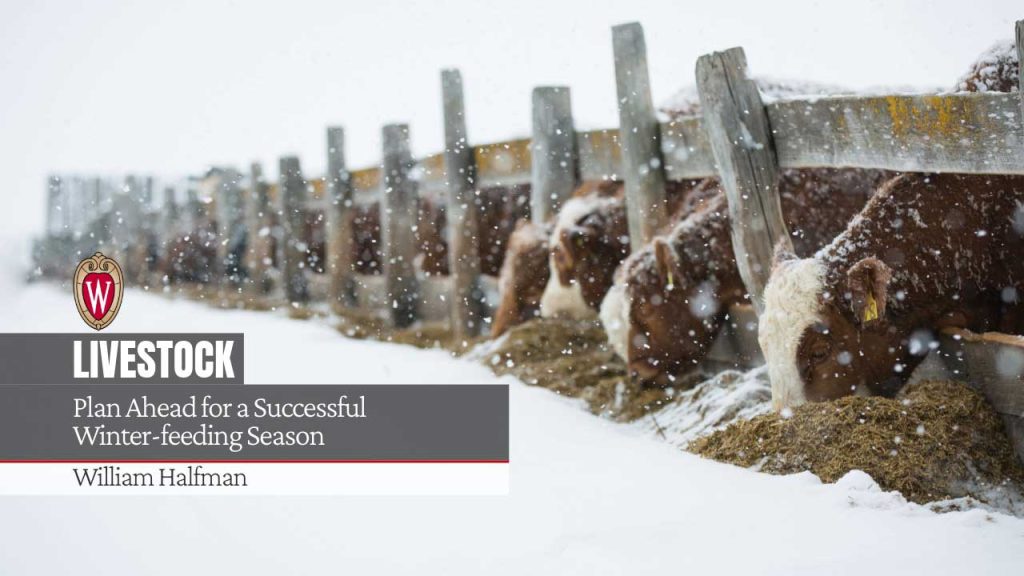
Winter is just around the corner, and so is winter feeding season for the beef cow herd. Now is the time to evaluate your forage inventory and compare it with the herd’s expected feed needs. Planning ahead can pay off in both the short and long term. If additional feed is needed, acting early provides more time to explore options, compare prices, and secure quality feed, rather than settling for last-minute purchases. Looking further ahead, ensuring the herd’s nutritional needs are met throughout the winter supports body condition, calving success, and rebreeding performance. This preparation increases the likelihood of stronger calf crops, improved herd performance, and greater profitability in the year to come.
Ideally, mature cows should maintain a BCS of 5 to 6. Mismanagement can result in cows that are either too thin or over-conditioned, both of which carry economic consequences. Thin cows are more likely to experience poor reproductive performance and reduced milk production, while over-conditioned cows face higher feed costs, increased risk of mobility issues, and a greater likelihood of dystocia. Table 1 highlights the impact of BCS on reproductive performance and revenue potential, using representative feeder calf sale prices from late summer 2025 in Wisconsin.
| BCS | 3 | 4 | 5 | 6 |
|---|---|---|---|---|
| Pregnancy rate, % | 43 | 61 | 86 | 93 |
| Calving interval, days | 414 | 381 | 364 | 364 |
| Calf average daily gain, lbs/day | 1.6 | 1.75 | 1.85 | 1.85 |
| Calf weaning weight, lbs | 374 | 460 | 514 | 514 |
| Calf price, $/cwt* | 420 | 410 | 400 | 400 |
| Revenue/cow exposed, $** | 675 | 1,150 | 1,768 | 1,912 |
Adapted from Kunkle et al.
*Late July 2025 representative Wisconsin feeder calf sale prices.
**Income per calf x pregnancy rate
The first step in developing a winter-feeding plan is to take inventory of the forages and feeds on hand. This inventory should include the quantity (how much is available) and the quality (nutritional value) of each lot. Ideally, forages should be stored and identified by cutting, harvest field, and other factors that may influence feed value. Elements such as crop maturity at harvest, weather conditions during harvest, and species composition can all affect forage quality. Sampling and laboratory testing of each lot provide the information needed to optimize their use in meeting herd requirements. Relying on visual appraisal alone can be misleading and may result in poor feed allocation decisions.
Quantity is best documented by weight, which can be estimated with reasonable accuracy by weighing a truck or wagon load of representative bales from each lot and then multiplying by the total bale count. Average bale weight is often quite different than what we assume, so this step is important. For silage piles or bags, weighing several loads and recording the number of loads hauled can provide a sound estimate if weighing every load is not practical. Alternatively, silage quantities in bags, piles, or bunkers can be estimated using measurements and density values – the more precise the input data, the more accurate the estimate. Finally, remember to account for storage losses (shrink) when determining available forage (Table 2).
| Storage type | Range of dry matter loss (%) |
|---|---|
| Under roof | 2 to 10 |
| Plastic wrap, on ground | 4 to 7 |
| Bale sleeve, on ground | 4 to 8 |
| Covered, rock pad or elevated | 2 to 17 |
| Uncovered, rock pad or elevated | 3 to 46 |
| Uncovered, on ground, net wrap | 6 to 25 |
| Covered, on ground | 4 to 46 |
| Uncovered, on ground | 5 to 61 |
Saxe
The second step is to determine the needs of the herd. A reputable animal nutritionist can be helpful with this process if a farmer does not have experience in this area. This involves formulating rations based on available forages to meet the herd’s nutritional needs. Production groups and their specific needs throughout the winter need to be considered. In the case of a cow-calf operation, this should include the mature cow group, young cows (2- and 3-year-olds), and replacement heifers. Replacement heifers include those set to calve in the coming spring, and those retained from the recently weaned calf crop. Farmers should not forget about the bulls. Some farms may also be backgrounding or finishing out additional calves. Each group will have different needs, and those needs will change throughout the year. For example, bred cows and heifers’ nutritional needs will increase once they enter the third trimester of pregnancy. Shortchanging them at that time can have negative impacts on their colostrum quality, milk production, and their calf’s health and vigor. Body condition score of each group needs to be considered when formulating rations to address any need to add, or in some cases reduce, condition.
Potential forage shortages or excesses can be estimated at this stage, along with supplement needs. Feeding losses should be accounted for here (Table 3), while storage losses should have already been considered during the inventory step. Many farmers also build in a cushion or surplus to prepare for longer winters or unexpected situations where extra feed may be needed. The amount of cushion varies by farm, but a minimum of 45 to 60 days is often a reasonable guideline for contingency planning. Some farmers prefer to maintain an even larger reserve to guard against weather-related shortages. Once forage needs and reserves are determined, a “shopping list” can be created while there is still time to compare options and secure feed at better prices.
| Feeder type | Percent loss |
|---|---|
| Ring without panel | 20 |
| Cradle feeder | 15 |
| Feeder wagon | 11.5 |
| Ring with panel | 6 |
| Cone feeder with panel | 3 |
Buskirk et.al
Putting the winter-feeding plan in writing or into a computer program improves both accuracy and implementation. University of Wisconsin-Extension offers a forage and feed inventory and usage estimating spreadsheet that can be a valuable tool in this process. The spreadsheet includes sections for estimating inventory, with tabs for silage stored in bags, piles, bunkers, and upright silos, as well as baled forages. While it does not balance rations, it does allow users to allocate forage from the inventory to different livestock groups on the farm, making it possible to estimate feed use, identify potential shortages or surpluses, and plan accordingly for the season. The spreadsheet is available here: https://livestock.extension.wisc.edu/decision-tools-and-software/#Feed-Inventory. Whether using paper and pencil or a digital tool, planning ahead and maintaining an accurate inventory provides more flexibility to improve herd management and performance, ultimately supporting long-term profitability.
This article originally appeared in the Midwest Forage Association Clippings newsletter.
Authors

William Halfman
Beef Outreach Specialist – Bill’s educational programming has focused on beef cattle production and management, agronomic crops and soils production and management, small scale fresh market and bedding plant production, and specialty crop management.
References
- Buskirk DD, Zanella AJ, Harrigan TM, Van Lente JL, Gnagey LM, Kaercher MJ. Large round bale feeder design affects hay utilization and beef cow behavior. J Anim Sci. 2003 Jan;81(1):109-15. Doi: 10.2527/2003.811109x. PMID: 12597379.
- Kunkle, W. E., Sand, R. S., & Rae, D. O. (1994). Effects of body condition on productivity in beef cattle. Department of Animal Science, Florida Cooperative Extension Service, UF/IFAS. SP-144. http://ufdc.ufl.edu/IR00004528/00001
- Saxe, C., Big bale storage losses, how different options stack up. Focus on forage fact sheet, University of Wisconsin Madison Division of Extension. https://fyi.extension.wisc.edu/forage/big-bale-storage-losses-how-different-options-stack-up/.
Reviewed by:
Beth McIlquham
UW-Madison Division of Extension, Regional Livestock Educator
Adam Hartfiel
UW-Madison Division of Extension, Regional Livestock Educator


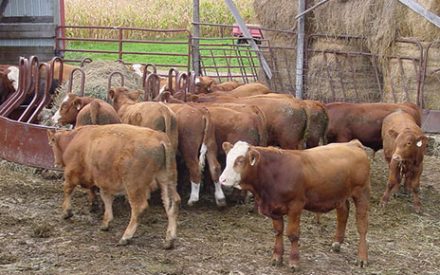 Do You Have Enough Forage? Four Steps to Figure Forage Inventory
Do You Have Enough Forage? Four Steps to Figure Forage Inventory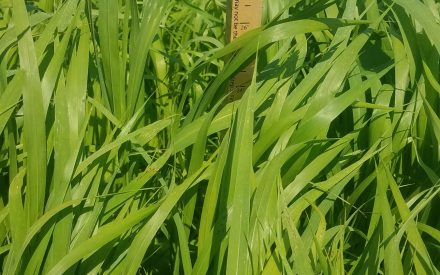 Annual Forages Provide Options
Annual Forages Provide Options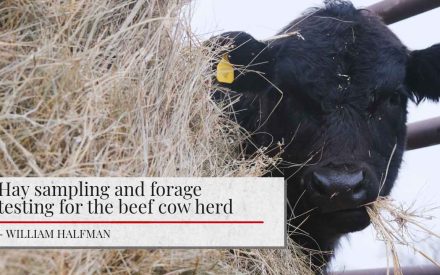 Hay sampling and forage testing for the beef cow herd
Hay sampling and forage testing for the beef cow herd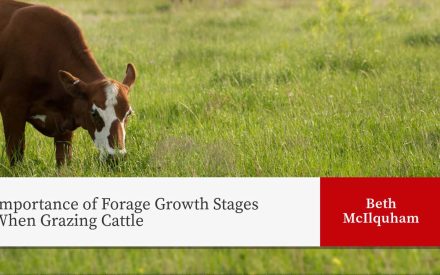 Importance of Forage Growth Stages When Grazing Cattle
Importance of Forage Growth Stages When Grazing Cattle


